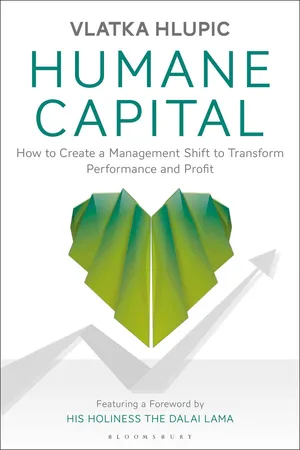
Humane Capital
How to Create a Management Shift to Transform Performance and Profit
- 320 pages
- English
- ePUB (mobile friendly)
- Available on iOS & Android
About This Book
Featuring a foreword by His Holiness the Dalai Lama. Despite decades of research and evidence, there is still extreme scepticism that businesses can combine a more humane style of management with superior shareholder returns, or that busy managers can be guided effectively by both their heads and their hearts. Vlatka Hlupic has spent 20 years investigating this paradox, developing an insightful critique of why such strong evidence has had limited impact and providing an alternative, practical approach that any employer can implement in order to overcome the unique challenges faced by their organizations. A clear correlation exists between companies that do well and companies that are good – that is to say, organizations that promote goodwill internally and externally, and work proactively with stakeholders, employees, society and customers to achieve those goals. A 'bad' company, on the other hand, may do well but its success is unlikely to be sustainable. Humane Capital explores the steps that businesses need to take in order to become a 'good' organization that can achieve long-term results. Supported by insights from interviews with 58 leading thinkers and practitioners in the field, Humane Capital argues for a radical reassessment of current business models. Using stories of managers from both the private and public sectors who have been effective in making the transition, Hlupic shows how successful leaders have moved their organizations from controlled and orderly to enthusiastic and collaborative – and shows how current leaders and managers can do the same.
Frequently asked questions
Information
PART I
WHY DO WE NEED TO HUMANIZE ORGANIZATIONS
1
The traditional business model is broken!
Business as usual is not an option anymore



Organizations face unprecedented challenges
| Volatility | This refers to a known external variable with a significant impact on a business that is highly unpredictable and beyond the control of a single enterprise. A recent example is the price of oil, which fell from in excess of $100 per barrel to around $30 in the period 2014 to 2016. |
| Uncertainty | This refers to a situation when the event’s basic cause and effect are not known. Change might be possible but it is not certain. An example might be the launch of the new product by competitor, where its impact on the business and market is not certain. |
| Complexity | This situation has multiple variable factors that affect outcomes. An example would be trading a complex service internationally, but under different regulatory regimes. |
| Ambiguity | Causal effects are all but impossible to ascertain – the context is wholly new and there are no precedents. An example is entering a new market with a new technology that is potentially disruptive and untested in that market. |
Table of contents
- Cover
- Half-Title Page
- Praise for Humane Capital
- Dedication
- Title Page
- Contents
- List of Tables
- List of Figures
- Foreword
- Preface
- Acknowledgements
- PART I Why do we ne ed to humanize organizations
- 1 The traditional business model is broken!
- PART II Humane capital interviews: What are the best practices that emerge from humanized organizations
- 2 Winning strategies: how the public sector achieves more with less
- 3 Profit and principle combined: Inspirational stories from the private sector
- 4 Entrepreneurial rising stars getting it right: Inspirational stories from SMEs
- 5 Humanized and humane: Winning strategies from the non-profit sector
- PART III How to leverage humane capital in your organization and transform workplace performance and profit
- 6 What the evidence tells us: Data patterns from interviewees show how the best-led organizations succeed
- 7 Creating positive ripples: The few affect the whole
- Appendix 1. Interview questions
- Appendix 2. List of interviewees
- Appendix 3. Demographic data for interviewees and their organizations
- Appendix 4. Research methodology underpinning the Humane Capital project
- Appendix 5. Level 4 companies identified by interviewees
- Appendix 6. The Management Shift Consulting Ltd services and tools
- Notes
- The Humane Capital® Board Game
- Index
- Copyright